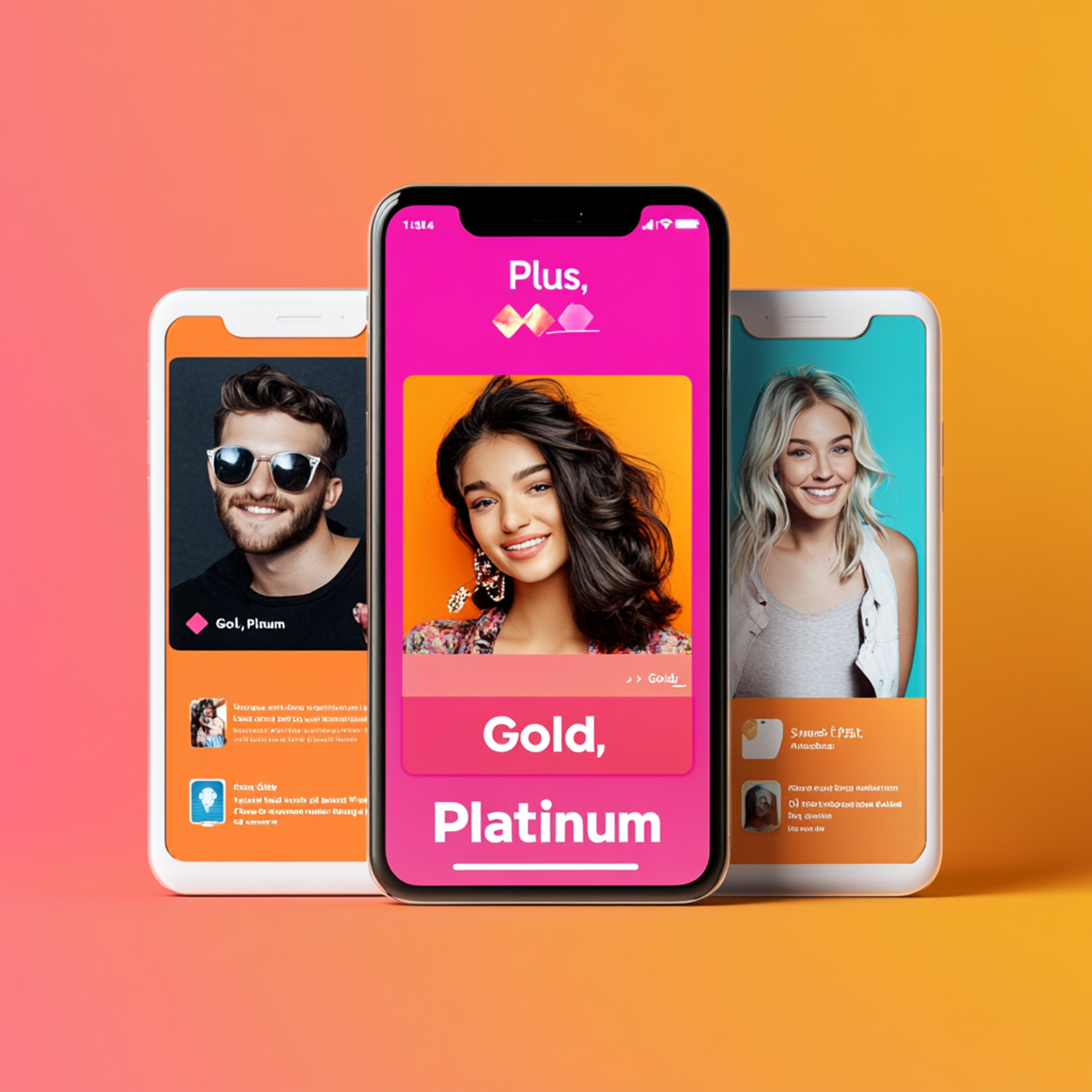
When most people think about Tinder, they picture swipes and matches. What they don't see is one of the most sophisticated monetization machines in mobile app history—a platform that transformed casual dating into a $1.94 billion revenue powerhouse.
For app developers and entrepreneurs looking to unlock sustainable revenue streams, Tinder's playbook offers invaluable insights. The dating giant didn't stumble into profitability; every feature, pricing decision, and user experience element serves a calculated monetization strategy.
Let's dissect exactly how Tinder converts user engagement into consistent revenue—and what your app development project can learn from their approach.
The Psychology Behind Tiered Subscriptions That Actually Work

Most apps treat subscriptions like simple paywalls. Tinder treats them like a carefully orchestrated value ladder. Their three-tier system—Plus, Gold, and Platinum—doesn't just gate features; it creates a sense of progression and status.
Here's where it gets interesting: every tier includes the same foundational benefits. Unlimited swipes, ad removal, and the ability to rewind accidental passes. These aren't premium features—they're friction reducers that make the core experience more enjoyable.
The real monetization magic happens in the differentiation. Gold subscribers get "Likes You," which eliminates the guesswork from matching. Platinum users receive priority placement and pre-match messaging capabilities. Each upgrade solves a specific user frustration while maintaining the app's core mechanics.
Smart app developers understand this principle: don't just add features to justify higher prices. Solve increasingly sophisticated user problems as they become more engaged with your platform.
Regional pricing adds another layer of sophistication. A Gold subscription costs $35 monthly in the United States but drops to under $5 in markets like India or Brazil. This isn't just about affordability—it's about maximizing conversion rates across vastly different economic landscapes.
At DETL, we've seen firsthand how thoughtful subscription architecture can transform app economics. The key lies in understanding user behavior patterns and designing upgrade paths that feel natural rather than forced.
Microtransactions: The Revenue Engine Behind the Subscriptions

While subscriptions provide predictable recurring revenue, Tinder's microtransaction strategy captures impulse spending at moments of peak emotional investment. Super Likes and Boosts tap into immediate user needs: standing out in crowded markets and getting instant visibility.
The genius lies in the timing. These features become available exactly when users feel most motivated to spend—after seeing an especially attractive profile or experiencing a matching dry spell. The app doesn't push these options constantly; instead, it presents them as solutions to immediate problems.
Consider the urban factor: 76% of Tinder's user base lives in cities where competition for attention is fierce. In dense dating markets, a Boost that pushes your profile to the top of the stack for 30 minutes provides genuine value. Users aren't just buying a feature; they're purchasing a competitive advantage.
The financial impact speaks for itself. In June 2024 alone, these microtransactions contributed significantly to Tinder's $82.64 million monthly revenue. With 75 million monthly active users, the platform demonstrates how small, strategic purchases can scale into massive revenue streams.
For app developers, the lesson is clear: identify moments when users face their biggest pain points, then offer immediate solutions through one-time purchases. DETL helps startups implement these behavioral triggers without compromising user trust or long-term engagement.
Geographic and Demographic Pricing: A Masterclass in Market Adaptation

Tinder's pricing strategy reveals something most apps get wrong: one-size-fits-all monetization leaves money on the table in every market. The platform adjusts not just for purchasing power, but for competitive landscapes and user behavior patterns across different regions.
Age-based pricing adds another controversial yet effective dimension. Users over 30 often pay premium rates for identical features, reflecting their higher lifetime value and different usage patterns. While this approach draws criticism, it demonstrates how demographic data can inform pricing decisions.
The platform also encourages direct subscriptions through their website, bypassing app store commission fees. Some users have discovered they can access lower prices using VPNs, highlighting just how aggressively Tinder segments its pricing based on location and behavior data.
This dynamic approach extends beyond pure pricing. City-specific features, localized promotional campaigns, and region-appropriate payment methods all contribute to conversion optimization. Tinder doesn't just translate their app—they adapt their entire monetization strategy for local markets.
Modern app development requires this level of pricing sophistication. At DETL, we help entrepreneurs build location-aware monetization systems that respond to real-time market conditions rather than fighting against them.
Behavioral Design: Converting Engagement Into Revenue

Tinder's user base skews young, urban, and digitally native—demographics that respond well to gamification and behavioral nudges. The platform leverages this through carefully designed engagement loops that naturally lead to monetization opportunities.
The "almost out of likes" notification exemplifies this approach. Rather than hard-stopping users at their daily limit, Tinder creates anticipation and offers immediate solutions. Users can either wait for their likes to refresh or purchase more through various upgrade paths.
Gender dynamics play a crucial role in monetization strategy. The predominantly male user base drives most subscription and boost purchases, seeking visibility and match parity in competitive markets. Female users, who typically receive more inbound interest, engage more with personalization features and curated experiences.
This segmentation allows Tinder to offer differentiated value propositions. Male users see features focused on increasing their reach and match rates. Female users encounter tools for filtering and controlling their experience. Both approaches solve real user problems while driving revenue.
The platform's algorithmic prioritization creates additional monetization pressure. Users who engage frequently and purchase premium features receive better profile placement, creating a positive feedback loop that rewards spending with improved results.
Revenue Performance: The Numbers Behind the Strategy

Tinder's financial performance validates their monetization approach. Revenue grew from $47 million in 2015 to $1.94 billion in 2024—a 42x increase that outpaces virtually every consumer app in its category.
April 2025 marked an all-time high with $171 million in monthly revenue. In a dating app market worth $6.18 billion annually, Tinder maintains dominant market share through continuous feature evolution and pricing optimization.
The platform contributes over 57% of Match Group's total revenue despite being just one app in their portfolio. This dominance comes from relentless user acquisition, dynamic pricing strategies, and feature development that keeps users engaged and spending.
Competition from Bumble, Hinge, and newer entrants hasn't slowed Tinder's growth. Their younger demographic provides advantages in testing new features and adapting to changing user preferences faster than legacy competitors.
For entrepreneurs evaluating monetization strategies, Tinder demonstrates that product-led revenue models can deliver exponential returns when combined with sophisticated pricing, personalization, and behavioral insights.
Key Takeaways for App Developers
Building sustainable app revenue requires more than great features—it demands understanding user psychology, market dynamics, and behavioral triggers that drive purchasing decisions.
Tinder's success stems from treating monetization as a core product function rather than an afterthought. Every feature serves dual purposes: enhancing user experience and creating natural upgrade opportunities.
The platform's global expansion strategy shows how pricing flexibility enables market penetration without sacrificing premium positioning. Regional adaptation goes beyond translation—it requires rethinking value propositions for different economic and cultural contexts.
At DETL, we help startups implement these monetization principles from day one. Rather than retrofitting revenue strategies onto existing products, we design apps with sustainable business models built into their core architecture.
The dating app market will continue evolving, but Tinder's monetization playbook offers timeless lessons about converting user engagement into lasting business value. For app developers ready to build their own revenue engines, these strategies provide a proven roadmap to profitability.




